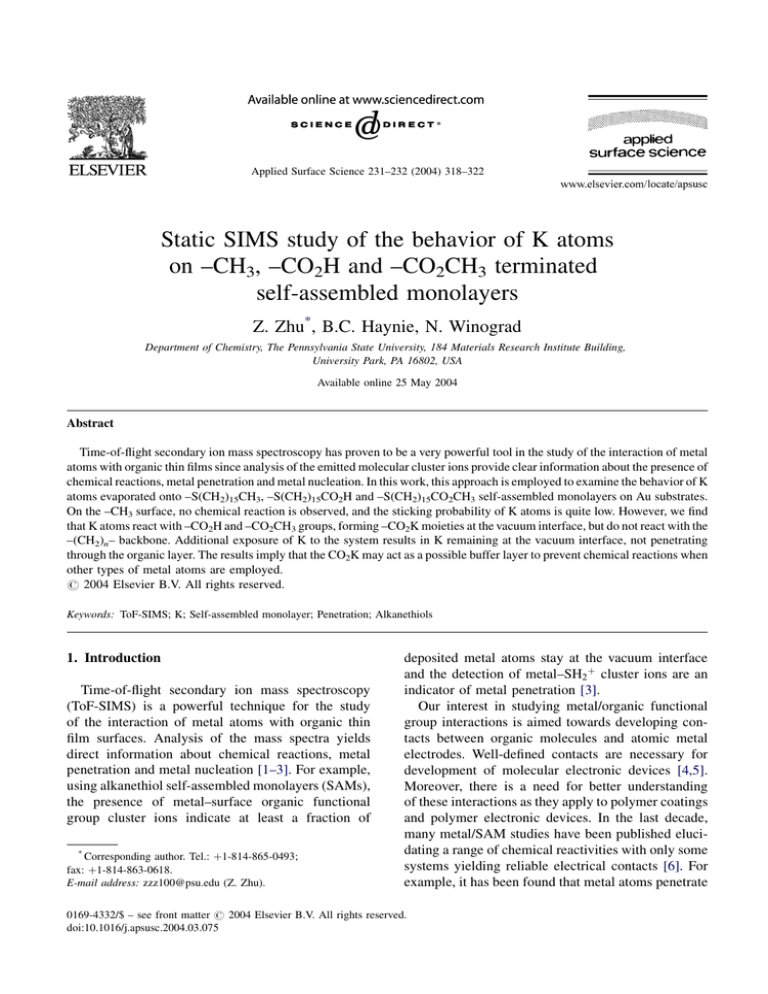
Applied Surface Science 231–232 (2004) 318–322
Static SIMS study of the behavior of K atoms
on –CH3, –CO2H and –CO2CH3 terminated
self-assembled monolayers
Z. Zhu*, B.C. Haynie, N. Winograd
Department of Chemistry, The Pennsylvania State University, 184 Materials Research Institute Building,
University Park, PA 16802, USA
Available online 25 May 2004
Abstract
Time-of-flight secondary ion mass spectroscopy has proven to be a very powerful tool in the study of the interaction of metal
atoms with organic thin films since analysis of the emitted molecular cluster ions provide clear information about the presence of
chemical reactions, metal penetration and metal nucleation. In this work, this approach is employed to examine the behavior of K
atoms evaporated onto –S(CH2)15CH3, –S(CH2)15CO2H and –S(CH2)15CO2CH3 self-assembled monolayers on Au substrates.
On the –CH3 surface, no chemical reaction is observed, and the sticking probability of K atoms is quite low. However, we find
that K atoms react with –CO2H and –CO2CH3 groups, forming –CO2K moieties at the vacuum interface, but do not react with the
–(CH2)n– backbone. Additional exposure of K to the system results in K remaining at the vacuum interface, not penetrating
through the organic layer. The results imply that the CO2K may act as a possible buffer layer to prevent chemical reactions when
other types of metal atoms are employed.
# 2004 Elsevier B.V. All rights reserved.
Keywords: ToF-SIMS; K; Self-assembled monolayer; Penetration; Alkanethiols
1. Introduction
Time-of-flight secondary ion mass spectroscopy
(ToF-SIMS) is a powerful technique for the study
of the interaction of metal atoms with organic thin
film surfaces. Analysis of the mass spectra yields
direct information about chemical reactions, metal
penetration and metal nucleation [1–3]. For example,
using alkanethiol self-assembled monolayers (SAMs),
the presence of metal–surface organic functional
group cluster ions indicate at least a fraction of
*
Corresponding author. Tel.: þ1-814-865-0493;
fax: þ1-814-863-0618.
E-mail address: zzz100@psu.edu (Z. Zhu).
deposited metal atoms stay at the vacuum interface
and the detection of metal–SH2 þ cluster ions are an
indicator of metal penetration [3].
Our interest in studying metal/organic functional
group interactions is aimed towards developing contacts between organic molecules and atomic metal
electrodes. Well-defined contacts are necessary for
development of molecular electronic devices [4,5].
Moreover, there is a need for better understanding
of these interactions as they apply to polymer coatings
and polymer electronic devices. In the last decade,
many metal/SAM studies have been published elucidating a range of chemical reactivities with only some
systems yielding reliable electrical contacts [6]. For
example, it has been found that metal atoms penetrate
0169-4332/$ – see front matter # 2004 Elsevier B.V. All rights reserved.
doi:10.1016/j.apsusc.2004.03.075
Z. Zhu et al. / Applied Surface Science 231–232 (2004) 318–322
through the Au substrate alkanethiolate SAMs if
metal/organic functional group interactions are weak
[1]. This is a serious technical impediment to fabrication of SAM-based nano-devices. Here we show that
alkali metal atoms, with their inherent ionic character,
may be employed as a possible buffer layer to allow
otherwise reactive metals to act as viable metal contacts. The data suggest that for K deposition on
carboxylic acid and ester terminated alkanethiols that
this ionic character dominates the van der Waals
interactions between molecules, blocking penetration
of subsequently deposited species. In general, we
illustrate the power of the ToF-SIMS approach for
characterizing such complex structures.
319
2. Experimental
A custom-designed ToF-SIMS instrument was used
in this paper, and the details of the instrument have
been described elsewhere [7]. The primary ions are
15 keV Gaþ ions, and the beam is rastered over a
300 mm 300 mm area. The total ion dose is less than
1012 ions/cm2 in all measurements. Atomic K was
deposited on top of the samples in a deposition
chamber using a dispenser (SAES getters), which
was located about 45 cm vertically above the SAM
samples, at a rate of 0.001 nm/s. Metal thickness was
monitored by a quartz crystal microbalance (Maxtek
TM400 controller, 6 MHz Sycon crystal head).
Fig. 1. Positive ion spectra of the –S(CH2)15CH3, –S(CH2)15CO2H and –S(CH2)15CO2CH3 monolayers before and after 0.05 and 0.63 nm K
deposition. From left to right, –S(CH2)15CO2H, –S(CH2)15CO2CH3, and –S(CH2)15CH3; from bottom to top, original samples, after 0.05 nm K
deposition, and after 0.63 nm K deposition.
320
Z. Zhu et al. / Applied Surface Science 231–232 (2004) 318–322
Self-assembled alkanethiolate monolayers of
–S(CH2)15CH3, –S(CH2)15CO2H and –S(CH2)15CO2CH3 on Au coated Si wafers were prepared and
characterized using previously published procedures
[8]. SIMS spectra of freshly prepared monolayers
were taken, and then the samples were transferred
under vacuum to the deposition chamber, where K
atoms were deposited on the samples. After K deposition, the samples were transferred back to the analysis
chamber to acquire SIMS spectra. After SIMS analysis, the samples were redosed with additional K. This
process was repeated for total K doses of 0.05, 0.15,
0.39, 0.63 and 0.93 nm. In another experiment, 1.2 nm
K was directly deposited on the samples, which were
then removed from vacuum and rinsed by millipore
water (18.2 MO cm). After drying, they were put back
into the analysis chamber.
3. Results and discussion
The positive ion spectra of –S(CH2)15CH3,
–S(CH2)15CO2H and –S(CH2)15CO2CH3 monolayers
before and after K deposition are shown in Fig. 1. We
find that after 0.05 nm of K deposition, the 39 Kþ peak
dominates the spectra of –S(CH2)15CO2H and –
S(CH2)15CO2CH3 monolayers. With additional
deposition, the relative intensity of the 39 Kþ peak
becomes stronger. However, the 39 Kþ peak in the
spectrum of the –S(CH2)15CH3 monolayer is relatively
weak even after 0.63 nm K deposition. This observation indicates that the sticking probability of K atoms
on the –CH3 surface is very low. When comparing the
Kþ peak intensities from the various samples, it is
found that the sticking probability of K atoms on the –
CH3 surface is no more than 2% of that on the –CO2H
or –CO2CH3 surface.
With K deposition on the –S(CH2)15CH3 surface,
Kþ peaks increase and all original peaks decrease,
but relative intensities between the original
peaks change only slightly. At the same time, characteristic negative ion peaks (AuSðCH2 Þ15 CH3 ,
Au2 SðCH2 Þ15 CH3 , Au½SðCH2 Þ15 CH3 2 ) increase
slightly, most probably due to the change of the
work function. Additionally, after the water rinse,
both positive and negative spectra of the
–S(CH2)15CH3 monolayer are almost the same as
the original spectra, except for a small Kþ residue.
All these data suggest that no chemical reaction
occurs. This result is in qualitative agreement with
previous work [9] on the behavior of sodium atoms
on a –S(CH2)21CH3 SAM on Au.
After K deposition on –S(CH2)15CO2H and
–S(CH2)15CO2CH3, the tail group related peaks, for
example, the CO2Hþ peak from –S(CH2)15CO2H
film and the CO2CH3þ peak from –S(CH2)15CO2CH3
film, decrease quickly, but the K2Oþ, K2 O2 þ , and
ðCH2 Þn CO2 K2 þ peaks become visible. This result
suggests that both the –CO2H and –CO2CH3 groups
react with K atoms, forming –CO2K adducts. Actually,
after K deposition, the spectra of –S(CH2)15CO2H and
–S(CH2)15CO2CH3 samples are very similar, implying
that a similar structure on both films forms after K
deposition.
In an attempt to determine whether K atoms penetrate through the SAMs, 1.2 nm of K, equivalent to
three atomic layers, was deposited on the samples. The
samples were then removed from vacuum, rinsed with
pure water, and returned to the analysis chamber. The
Kþ peak of a –S(CH2)15CO2H sample processed in
this fashion is shown in Fig. 2. Only a small amount of
Kþ remains in the system after the water rinse. We
believe that most K atoms (both K atoms of CO2K
groups and charge-free K atoms) react with water
Fig. 2. Positive ion spectra of: (a) a –S(CH2)15CO2H monolayer,
(b) the sample after 1.2 nm K deposition, and (c) the sample after
1.2 nm K deposition and water rinse. In spectrum (b) the intensity
of the 39 Kþ is saturating the detector and the peak observed
near 39.02 is actually due to a spurious oscillation, and not to the
C3 H3 þ ion.
Z. Zhu et al. / Applied Surface Science 231–232 (2004) 318–322
321
molecules. More importantly, the –CO2K layer
seems to block further K atoms from penetrating
through the film, indicating a surface –CO2K layer
may be a good barrier to block metal penetration.
This layer may also protect organic molecules from
the destruction of more chemically active metals
such as Ti and Ca. Thus, with an ionic surface layer
such as –CO2K, SAM-based nano-electric devices
might be able to be fabricated free of defects associated with metal penetration and organic molecule
damage.
4. Conclusion
Fig. 3. Negative ion spectra of: (a) a –S(CH2)15CO2CH3 monolayer, (b) the –S(CH2)15CO2CH3 monolayer after 1.2 nm K
deposition and water rinse, and (c) a –S(CH2)15CO2H sample.
molecules and are then rinsed by further water. This is
strong evidence that most of the K atoms stay at the
vacuum interface and do not penetrate through the
organic layer, because, if K atoms get to the Au–S
interface, water rinsing theoretically would not
remove them due to the compact structure of the film.
Similar results are also found for the –S(CH2)15CO2CH3 system.
Comparing the spectra of a –S(CH2)15CO2H monolayer and the same sample after 1.2 nm of K deposition and water rinse, it is found that they are almost
identical, with only slightly difference in peak intensities. This result indicates that the organic molecules
are not destroyed after 1.2 nm K deposition.
An interesting result is that the spectra of the
–S(CH2)15CO2CH3 sample after 1.2 nm of K deposition and water rinse are almost the same as the spectra
of the –S(CH2)15CO2H sample. The AuSðCH2 Þ15 peak is shown in Fig. 3. This peak is characteristic
of the –S(CH2)15CO2H monolayer, and the
Au2 SðCH2 Þ15 CO2 CH3 peak is characteristic of the
–S(CH2)15CO2CH3 monolayer. This result indicates
that almost all –CO2CH3 groups react with K atoms,
forming –CO2K groups and the (SðCH2 Þ15 CO2 )
moiety of the HS(CH2)15CO2CH3 molecule is not
destroyed during K deposition.
As the data suggest, K atoms react with the
–CO2H and –CO2CH3 group, forming a –CO2K
layer at the surface, but do not destroy the organic
The ToF-SIMS approach is powerful for the study
of the behavior of K atoms on organic thin films such
as those examined here. The data show that the –CH3
groups do not react with K atoms and that the
sticking probability of K atoms on the –CH3 surface
is quite low. Both the –CO2H groups and –CO2CH3
groups react with K atoms, forming the –CO2K
adduct. Additional K atoms stay at the vacuum
interface and do not penetrate through the organic
thin films. At the same time, K atoms do not destroy
the backbone of organic molecules. A surface –
CO2K layer may be a promising buffer layer to
block metal penetration and protect monolayer
molecules.
Acknowledgements
The authors acknowledge NSF for partial financial
support of this work. The assistance of David Allara
and his research group in suggesting experiments
and in providing many of the SAMs is greatly
appreciated.
References
[1] A. Hooper, G.L. Fisher, K. Konstadinidia, D. Jung, H. Nguyen,
R. Opila, R.W. Collins, N. Winograd, D.L. Allara, J. Am.
Chem. Soc. 121 (1999) 8052–8064.
[2] G.L. Fisher, A.V. Walker, A.E. Hooper, T.B. Tighe, K.B.
Bahnck, H.T. Skriba, M.D. Reinard, B.C. Haynie, R.L. Opila,
N. Winograd, D.L. Allara, J. Am. Chem. Soc. 124 (2002)
5528–5541.
322
Z. Zhu et al. / Applied Surface Science 231–232 (2004) 318–322
[3] B.C. Haynie, A.V. Walker, T.B. Tighe, D.L. Allara, N.
Winograd, Appl. Surf. Sci. 203–204 (2003) 433–436.
[4] C. Joachim, J.K. Gimzewski, A. Aviram, Nature 408 (2000)
541–548.
[5] K.W. Hipps, Science 294 (2001) 536–537.
[6] D.R. Jung, A.W. Czanderna, Crit. Rev. Solid State 19 (1994)
1–54.
[7] R.M. Braun, P. Blenkinsopp, S.J. Mullock, C. Corlett, K.F.
Willey, J.C. Vickerman, N. Winograd, Rapid Commun. Mass
Spectrosc. 12 (1998) 1246–1252.
[8] R.G. Nuzzo, L.H. Dubois, D.L. Allara, J. Am. Chem. Soc. 112
(1990) 558–569.
[9] F. Balzer, K. Bammel, H.-G. Rubahn, J. Chem. Phys. 98 (1993)
7625–7635.






